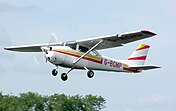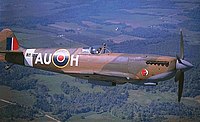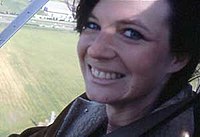Portal:Aviation
| Main page | Categories & Main topics |
|
Tasks and Projects |
The Aviation Portal

Aviation includes the activities surrounding mechanical flight and the aircraft industry. Aircraft includes fixed-wing and rotary-wing types, morphable wings, wing-less lifting bodies, as well as lighter-than-air craft such as hot air balloons and airships.
Aviation began in the 18th century with the development of the hot air balloon, an apparatus capable of atmospheric displacement through buoyancy. Some of the most significant advancements in aviation technology came with the controlled gliding flying of Otto Lilienthal in 1896; then a large step in significance came with the construction of the first powered airplane by the Wright brothers in the early 1900s. Since that time, aviation has been technologically revolutionized by the introduction of the jet which permitted a major form of transport throughout the world. (Full article...)
Selected article

Selected image
Did you know
...that on October 5, 1914, a French Voisin III pilot scored the first air-to-air kill of World War I? ...that Indra Lal Roy of the Royal Air Force became India's first flying ace after he achieved 10 victories in thirteen days during World War I? ...that the Lockheed NF-104A (pictured), equipped with a reaction control system as well as a rocket engine to supplement a jet engine, was a low-cost training vehicle for American astronauts in the 1960s?
General images -
In the news
- May 29: Austrian Airlines cancels Moscow-bound flight after Russia refuses a reroute outside Belarusian airspace
- August 8: Passenger flight crashes upon landing at Calicut airport in India
- June 4: Power firm helicopter strikes cables, crashes near Fairfield, California
- January 29: Former basketball player Kobe Bryant dies in helicopter crash, aged 41
- January 13: Iran admits downing Ukrainian jet, cites 'human error'
- January 10: Fire erupts in parking structure at Sola Airport, Norway
- October 27: US announces restrictions on flying to Cuba
- October 3: World War II era plane crashes in Connecticut, US, killing at least seven
- September 10: Nevada prop plane crash near Las Vegas leaves two dead, three injured
- August 6: French inventor Franky Zapata successfully crosses English Channel on jet-powered hoverboard
Related portals
Associated Wikimedia
The following Wikimedia Foundation sister projects provide more on this subject:
-
Commons
Free media repository -
Wikibooks
Free textbooks and manuals -
Wikidata
Free knowledge base -
Wikinews
Free-content news -
Wikiquote
Collection of quotations -
Wikisource
Free-content library -
Wikiversity
Free learning tools -
Wikivoyage
Free travel guide -
Wiktionary
Dictionary and thesaurus
Selected biography
Despite her surname, Jeana Yeager is not related to Chuck Yeager, the first man to break the sound barrier in level flight.
Selected Aircraft

The Supermarine Spitfire was a single-seat fighter used by the RAF and many Allied countries in World War II.
Produced by Supermarine, the Spitfire was designed by R.J. Mitchell, who continued to refine it until his death from cancer in 1937. The elliptical wing had a thin cross-section, allowing a faster top speed than the Hurricane and other contemporary designs; it also resulted in a distinctive appearance. Much loved by its pilots, the Spitfire saw service during the whole of World War II, in all theatres of war, and in many different variants.
More than 20,300 examples of all variants were built, including two-seat trainers, with some Spitfires remaining in service well into the 1950s. It was the only fighter aircraft to be in continual production before, during and after the war.
The aircraft was dubbed Spitfire by Sir Robert MacLean, director of Vickers (the parent company of Supermarine) at the time, and on hearing this, Mitchell is reported to have said, "...sort of bloody silly name they would give it." The word dates from Elizabethan times and refers to a particularly fiery, ferocious type of person, usually a woman. The name had previously been used unofficially for Mitchell's earlier F.7/30 Type 224 design.
The prototype (K5054) first flew on March 5, 1936, from Eastleigh Aerodrome (later Southampton Airport). Testing continued until May 26, 1936, when Mutt Summers (Chief Test Pilot for Vickers (Aviation) Ltd.) flew K5054 to Martlesham and handed the aircraft over to Squadron Leader Anderson of the Aeroplane & Armament Experimental Establishment (A&AEE).
- Length: 29 ft 11 in (9.12 m)
- Wingspan: 36 ft 10 in (11.23 m)
- Height: 12 ft 8 in (3.86 m)
- Number Built: 20,351 (excluding Seafires)
- Maximum speed: 330 knots (378 mph, 605 km/h)
- Maiden flight: March 5, 1936
- Powerplant: 1× Rolls-Royce Merlin 45 supercharged V12 engine, 1470 hp at 9250 ft (1096 kW at 2820 m)
Today in Aviation
- 2011 – Nusantara Buana CASA C-212 crash: A CASA C-212 Aviocar operated by Nusantara Buana Air, crashed half way through its flight from Polonia International Airport in Indonesia. The crash killed all eighteen people on board; fourteen passengers and four crew.
- 2009 – Greek state-owned airline Olympic Airlines ceased operation.It was replaced by privately owned Olympic Air, which commenced operations on this day.
- 2009 – British Airways operates the first transatlantic flight from London City Airport: BA001 (a flight number unused since Concorde retired), an all-business class Airbus A318.
- 2007 – Dash 8 landing gear incidents: Two separate failures occurred within four days of each other on Bombardier Dash 8-Q400 aircraft, all operated by Scandinavian Airlines (SAS). A third incident, again with an SAS aircraft, occurred in October 2007, leading to the withdrawal of the type from the airline’s fleet.
- 2006 – Gol Transportes Aéreos Flight 1907, a Boeing 737-800, collides with an Embraer Legacy business jet and crashes in Mato Grosso, Brazil; the Embraer Legacy, with seven on board, lands safely with no reported injuries while all 154 people on board the Boeing 737 perish; this crash marks the first loss of a Boeing 737-800.
- 2004 – The Burt Rutan Ansari X Prize entry SpaceShipOne performed a successful spaceflight, the first of two needed to win the prize.
- 1998 – Lionair Flight 602, an Antonov An-24, is shot down by the Liberation Tigers of Tamil Eelam and crashes off the coast of Jaffna, Sri Lanka, killing all 55 on board.
- 1988 – Launch: Space Shuttle Discovery STS-26 at 15:37:00 UTC. Mission highlights: TDRS deployment; first post Challenger flight.
- 1995 – The United States Navy disestablishes Fighter Squadron #84 (VF-84), the celebrated Jolly Rogers.
- 1988 – NASA resumes space shuttle flights, grounded after the Challenger disaster, with STS-26.
- 1971 – A USAF Lockheed C-5A Galaxy of the 443d Military Airlift Wing, Altus AFB, Oklahoma, one of six used for training, had its number one (port outer) engine tear off the pylon while advancing take-off power before brake release, setting the wing on fire. The crew evacuated safely within 90 seconds and the fire was extinguished by emergency equipment. The engine had flown up and behind the Galaxy, landing some 250 yards to the rear. The Air Force subsequently grounded six other C-5s with similar flight hours and cycles. Further investigation found cracks in younger C-5s and the entire fleet was grounded.
- 1964 – The first take-off and landing of the LTV-Hiller-Ryan XC-142 A vertical take-off transport is made in Dallas, Texas. The aircraft has four 2,850-hp General Electric turboprops mounted on the wings that can pivot 90 degrees to allow for a vertical take-off.
- 1959 – Braniff Flight 542, a Lockheed L-188 Electra, breaks up in mid-air and crashes 4 miles (6.4 km) from Buffalo, Texas; all 34 on board perish.
- 1954 – The new Downsview Ontario plant of DeHavilland Aircraft of Canada Ltd was opened by the Right Honourable CD Howe.
- 1954 – First flight of the McDonnell F-101 Voodoo jet fighter makes its first flight, flown by test pilot Robert C. Little. An advanced design of the XF-88, the Voodoo goes supersonic on its first flight.
- 1951 – A Royal Air Force Boeing Washington B.1, WF555, of 57 Squadron, RAF Waddington, experiences runaway propeller on number 3 (starboard inner) engine which hits number 4 (starboard outer) causing severe damage. Three crew in rear fuselage ordered to bail out before bomber makes successful wheels-up landing at a disused airfield near Amiens, France - no casualties, but airframe written off. Scrapped 3 January 1952.
- 1948 – First flight of the Vought XF7U-1 Cutlass, a prototype of the F7U Cutlass
- 1946 – The United States Navy Lockheed P2 V Neptune Truculent Turtle, piloted by Commander Thomas D. Davies and aided by four JATO rockets, departs Perth, Australia, bound nonstop for Naval Air Station Anacostia in Washington, D. C. On take-off, it weighs 85,575 lbs (38,817 kg), the heaviest twin-engine aircraft ever to take off up to that time. Although bad weather forces the plane to land short of Washington in Columbus, Ohio, after 55 hours 17 min continuously in the air, the flight nonetheless sets a new nonstop, unrefueled world distance record of 11,235.6 nautical miles (20,807 km) which stands for 16 years until broken by a U. S. Air Force B-52 H Stratofortress in 1962.
- 1946 – Blue Angels pilot Lt. (JG) Ros "Robby" Robinson is killed in Grumman F8F-1 Bearcat, BuNo 95986, Blue Angels No. 4, at NAS Jacksonville, Florida, when he fails to pull out of a dive during a Cuban Eight manoeuvre - wingtip broke off his fighter.
- 1945 – Silverplate Boeing B-29 Superfortress, 44-27303, named "Jabit III", of the 509th Composite Group, Wendover Army Air Field, Utah, on cross-country training mission, strikes several objects on landing at Chicago Municipal Airport, Illinois, never flies again. Assigned to the 4200th Base Unit at the airport pending disposition decision, it is salvaged there in April 1946.
- 1940 – The 1940 Brocklesby mid-air collision occurred over Brocklesby, New South Wales, Australia. The accident was unusual in that the aircraft involved, two Avro Ansons of No. 2 Service Flying Training School RAAF, remained locked together after colliding, and then managed to land safely. Both navigators bailed out after the aircraft struck, followed shortly afterwards by the injured pilot of the lower Anson. The pilot of the upper Anson, however, found that he was able to control the interlocked aircraft using his ailerons and flaps, coupled with the still-functioning engines on the machine underneath. He was then able to make a successful emergency landing in a paddock near Brocklesby. All four crewmen survived the incident, and the Ansons were repaired and remained in service with the Air Force.
- 1934 – A London, Scottish & Provincial Airways Airspeed Courier crashes at Tiverton Bottom, Shoreham, Kent, in the United Kingdom, killing all four people on board. Flying debris injures two people on the ground.
- 1931 – First flight of the Marinens Flyvebaatfabrikk M.F.11
- 1931 – Following the Schneider Trophy success, Flt Lt. George Stainforth in S.6 B serial S1596 breaks the 400 mph air speed record barrier at 407.5 miles per hour (655.8 km/h).
- 1929 – The first flight at Cartierville of Reid Rambler. A Canadian-designed and built trainer; it was intended to fill the needs of flying clubs. It was a sesquiplane with folding wings to facilitate storage and it had incorporated Warren truss bracing that eliminated the need for bracing wires.
- 1929 – Dieudonne Costes and Maurice Bellonte arrive in Manchuria in a Breguet 19 (right), having set a new distance record of 7,905 km (4,912 miles) from Le Bourget, France.
- 1927 – Georg Wulf, co-founder of Focke-Wulf, is killed in the crash of the first Focke-Wulf F 19 Ente ("Duck"), D-1960. Second airframe is constructed, eventually put on display in Berlin air museum, destroyed in bombing raid in 1944.
- 1922 – First flight of the Thomas-Morse R-5, also known as the Thomas-Morse TM-22
- 1921 – First Orenco D manufactured by Curtiss, 63281, McCook Project Number 'P163', loses entire leading edge of its upper wing, crashing at McCook Field, Ohio. An investigation by an officer of the flying test section of the USAAS Engineering Division reveals that the Orenco Ds are badly constructed, no fewer than 30 defects and faulty fittings being recorded in the published report, forcing the Air Service to withdraw all Orenco Ds from use (Joe Baugher cites date of 28 September).
- 1918 – Second Lieutenant Frank Luke, the second-highest-scoring American ace of World War I with 18 victories, is killed in action.
- 1909 – Wilbur Wright begins flights as part of New York City’s Hudson-Fulton Celebration.
- 1907 – Louis Breguet and Charles Robert Richet demonstrate their Breguet-Richet Gyroplane No. 1, the first rotorcraft to lift a person off the ground. (The craft is still controlled by handlers standing around it on the ground).
References
- Shortcuts to this page: Portal:Airplanes • P:AVIA





















































